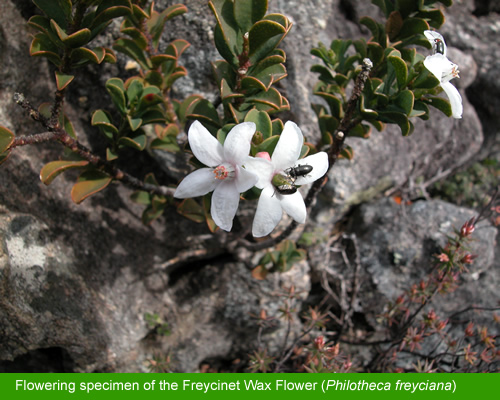
Summary of final report on the Australian Flora Foundation funded project:
Ms Natalie Papworth & Dr Alan MacFadyen, Royal Tasmanian Botanical Gardens, Hobart, Tasmania, 7001.
Mr Alan Gray,Tasmanian Herbarium, GPO Box 1164, Hobart, Tasmania 7001.
Dr Anthony Koutoulis and Ms Aina Price, School of Plant Sciences, University of Tasmania, GPO Box 252-55, Hobart, Tasmania 7001.
Dr Andrew Rozefelds, Tasmanian Museum and Art Gallery, GPO Box 1164, Hobart Tasmania, 7001.
Grant Details Final Report
Surveys undertaken on the Freycinet Peninsula found over 100 plants of the critically endangered Freycinet Wax Flower (Philotheca freyciana). All plants are restricted to the Hazards, and a single plant is also known from nearby Cape Tourville. The Freycinet Wax Flower is restricted to skeletal soils derived from granitic rocks, and it often occurs in runnels and in vertical crack lines in the granitic terrain. The Freycinet Wax Flower is likely to be slow growing, although both young and mature plants were located, which indicates recruitment is occurring in the wild.
As the species is critically endangered a number of propagation techniques were attempted, including seed, tissue culturing and standard vegetation propagation, to establish an ex situ population. Standard nursery vegetative propagation methods were found to be the most effective, and as a result the Royal Tasmanian Botanical Gardens (RTBG) now holds 70 cutting-produced plants in pots from various genotypes. The project has successfully established an ex situ collection of this critically endangered species at the RTBG.
Tissue culture techniques have successfully resulted in shoot proliferation, but we have been unable to induce root initiation in explants to date. If we can successfully overcome this challenge it will become possible to explore the horticultural potential of this attractive species.
